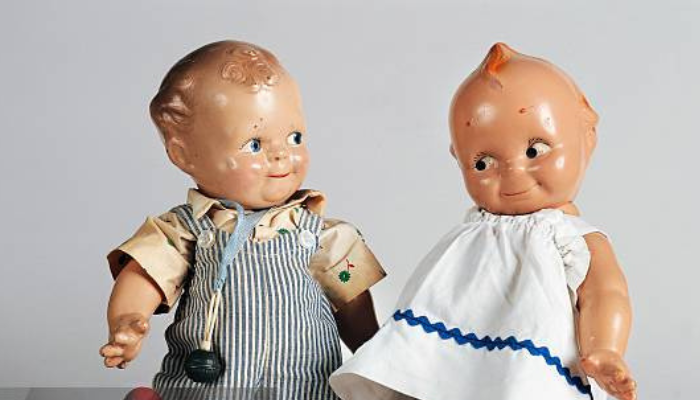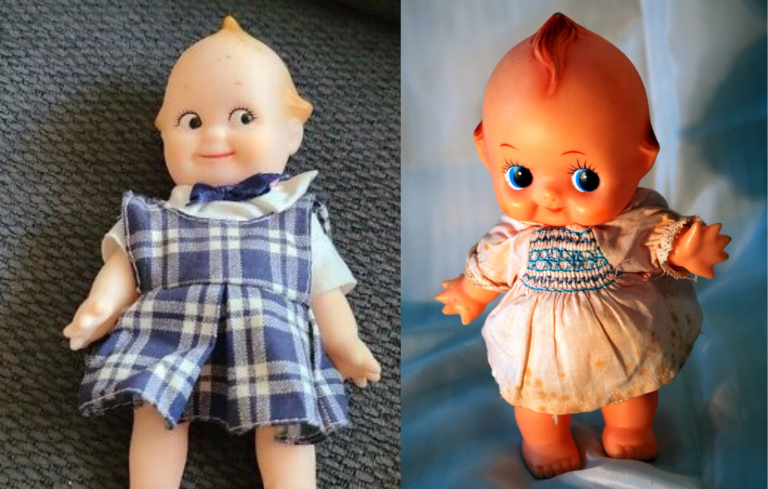Isn’t every baby as cute as a Kewpie? We sure think so! Whether you know them from your favorite mayonnaise, as a classic carnival prize, or as the mascot of a popular pizza bar, Kewpie Dolls have been beloved since the early 1900s. These adorable dolls, first conceived as illustrated characters by cartoonist Rose O’Neill, have a rich history and continue to charm collectors and fans worldwide.
Origins of Kewpie Doll
The Creator – Rose O’Neill
The story of Kewpie Doll begins with the talented Rose O’Neill, an American cartoonist, illustrator, and writer. O’Neill was a pioneering female artist in a male-dominated field. She created the Kewpie characters in 1909, originally as a series of illustrations for Ladies’ Home Journal. The name “Kewpie” is derived from “Cupid,” the Roman god of love, and these cherubic characters quickly captured the public’s imagination with their mischievous and endearing antics.
Early Designs and Materials
Inspired by her illustrations’ popularity, O’Neill decided to bring Kewpies to life as doll. The first Kewpie Dolls were made of Bisque, a type of unglazed porcelain, and were produced in Germany around 1912. These early doll were small, typically around 4 to 12 inches tall, and featured jointed limbs, big blue eyes, a top-knot hairstyle, and tiny wings on their backs. The success of these dolls helped to inspire other highly collectible dolls of the era, such as the ‘Googly Dolls,’ which shared similar whimsical features.
Evolution and Manufacturing
Transition to Modern Materials
As the demand for Kewpie Doll grew, so did the need for more durable and accessible materials. In the mid-20th century, the production of Kewpie Dolls shifted from Bisque to a more affordable and resilient material – plastic. Today, the Japanese doll company Obitsu produces Kewpie Dolls using soft PVC plastic. This material allows for a higher level of detail and articulation while being more durable and easier to clean than the original Bisque.
Design and Features
Modern Kewpie Doll retain the charming features that made them popular over a century ago. They have large, expressive blue eyes, starry fingers, and tiny wings on their backs. These dolls are articulated for movement, allowing them to sit or stand with their arms up or down. The attention to detail in their design, from their chubby cheeks to their playful expressions, makes them a delight for collectors and children alike.
Cultural Impact and Popularity
Kewpie in Popular Culture
Kewpie Doll have become an enduring symbol in popular culture. They are perhaps most famously associated with Kewpie mayonnaise, a Japanese brand that features the doll on its packaging. Additionally, Kewpie Dolls have been a staple prize at carnivals and fairs for decades, often awarded to winners of ring toss and other games. Their image has also been used in advertising and as mascots for various businesses, including a popular pizza bar on Brunswick Street.
Collectibility and Variations
Over the years, Kewpie Dolls have remained a beloved collectible item. Collectors seek out both vintage Bisque dolls and modern PVC versions, with some rare early dolls fetching high prices at auctions. Today, Kewpie Dolls are available in multiple sizes, from tiny pocket-sized versions to larger dolls that can stand over a foot tall. This variety allows collectors to find the perfect Kewpie to add to their collection or gift to a loved one.
Caring for Your Kewpie Doll
Maintenance Tips
Kewpie Doll are designed to be durable, but proper care will ensure they remain in good condition for years to come. For PVC dolls, it’s important to occasionally clean them to prevent dirt and grime buildup. If you take your Kewpie Doll into the bath, be sure to occasionally pop out their limbs to clean out any water residue. This will help prevent mold or mildew from forming inside the doll.
Storage and Display
Proper storage and display are key to preserving the quality of your Kewpie Doll. Keep your doll in a cool, dry place away from direct sunlight, as prolonged exposure to UV rays can cause the colors to fade. Displaying your Kewpie Doll in a glass cabinet or on a high shelf can protect it from dust and accidental damage while allowing you to show off its adorable features.
Where to Buy Kewpie Dolls
Online Retailers
If you’re looking to add a Kewpie Doll to your collection, several reputable online retailers specialize in vintage and modern dolls. Websites like eBay and Etsy often have a wide selection of Kewpie Dolls, ranging from antique Bisque dolls to newer PVC versions. Be sure to check the seller’s ratings and reviews to ensure you’re purchasing from a reliable source.
Local Shops
In addition to online retailers, local shops and specialty stores may also carry Kewpie Dolls. If you’re on Brunswick Street, for example, you might find Kewpie Dolls at a nearby pizza bar or other local businesses that embrace the doll’s charming aesthetic. Antique shops and doll collectors’ fairs are also great places to find unique and rare Kewpie Dolls.
Conclusion
Kewpie Doll have captured hearts worldwide for over a century with their adorable features and charming history. From their origins as illustrations by Rose O’Neill to their evolution into beloved dolls made of Bisque and PVC, Kewpie Dolls remain a cherished collectible and a symbol of joy and whimsy. Whether you’re a seasoned collector or new to the world of Kewpie, these dolls are sure to bring a smile to your face.
Additional Elements
FAQs Section
What is a Kewpie Doll? A Kewpie Doll is a small, cherubic doll characterized by its large blue eyes, starry fingers, tiny wings on the back, and a playful expression. Originally created by cartoonist Rose O’Neill, Kewpie Dolls have been popular since the early 1900s.
Who created the Kewpie Doll? Kewpie Doll were created by Rose O’Neill, an American cartoonist, illustrator, and writer. She first introduced the Kewpie characters in 1909 through her illustrations in Ladies’ Home Journal.
How should I clean my Kewpie Doll? To clean a PVC Kewpie Doll, gently wipe it with a damp cloth. If the doll has been in the bath, occasionally pop out the limbs to clean out any water residue to prevent mold or mildew.
Where can I buy a Kewpie Doll? Kewpie Dolls can be purchased from online retailers like eBay and Etsy, as well as local shops and specialty stores. Antique shops and doll collectors’ fairs are also good places to find unique and rare Kewpie Dolls.

